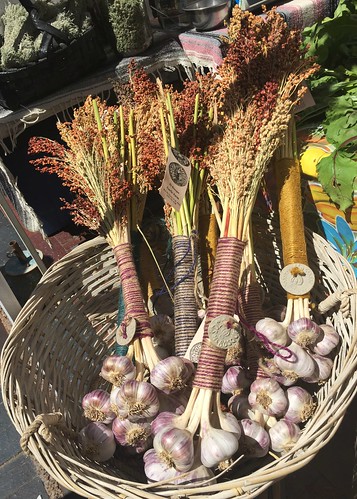
Investing in local food systems creates market opportunities for businesses entrepreneurs to sell fresh local products in unique ways. El Bosque Garlic Farms sells their hand-tied garlic at the Santa Fe Farmers Market. Photo courtesy of Peter Wood, USDA.
Every community wants to support initiatives that promote economic growth and create new jobs, but sometimes it can be hard to decide on the best way to accomplish these goals. Now there is a new resource to help communities make the economic case for investments in local food. Today, Secretary Tom Vilsack announced the availability of “The Economics of Local Food Systems: A Toolkit to Guide Community Discussions, Assessments and Choices” at the Good Food Festival’s Financing and Innovation Conference in Chicago. Secretary Vilsack highlighted USDA’s continued support of local and regional food systems, much of which is coordinated through USDA’s Know Your Farmer, Know Your Food initiative.
At USDA, we’ve seen how increasing consumer demand for locally-produced food is creating market opportunities for farmers, ranchers, and businesses throughout the supply chain. The toolkit will help local food stakeholders tell the story of how investing in strong local and regional food systems – including farmers markets, food hubs, and other local food outlets – can revitalize rural and urban economies across the country. The Local Food System Toolkit – developed by USDA’s Agricultural Marketing Service (AMS) – allows communities to conduct reliable economic impact assessments of investing in local food system initiatives. It includes seven modules and guidance to evaluate investments in local and regional food systems.
Places like Elgin, Texas, will be able to use the toolkit to justify investing in local food projects that help farmers, entrepreneurs, and institutional buyers develop new markets. Elgin developed a business plan focused on a value-added local food processing center, which serves as an aggregation and processing site for farmers from across the region to market their local fruits and vegetables. With the toolkit, they can better understand how this investment is creating jobs and economic opportunities.
The Toolkit uses real-world projects, experiences, and applied research, making it a practical and useable resource for community leaders, businesses, and others. For example, just outside Chicago, Kane County regional planners wanted to evaluate the economic and farmland preservation potential of investing in local food. One of the Toolkit modules shows how the planners were able to determine that adding 1,000 acres into local fruit and vegetable production would result in a $5.3 million increase in total industrial output, a $2.43 million increase in value-added production, and a $1.8 million increase in labor income based on the creation of 35 new jobs. With this information, Kane County had the data it needed to make the case for a local food project.
AMS has a long history of supporting applied local food research, and the agency continues to release publications to help communities and businesses build local food systems across the country. In addition to the Toolkit, AMS offers the Regional Food Hub Resource Guide which outlines the role that food hubs can play in regional food systems and their economic contributions to local communities. Another valuable resource is Moving Food Along the Value Chain: Innovations in Regional Food Distribution, a report that provides information on how producers can tap into growing consumer demand for local and regional food, create additional economic opportunities, and expand access to fresh, locally produced food.
No comments:
Post a Comment